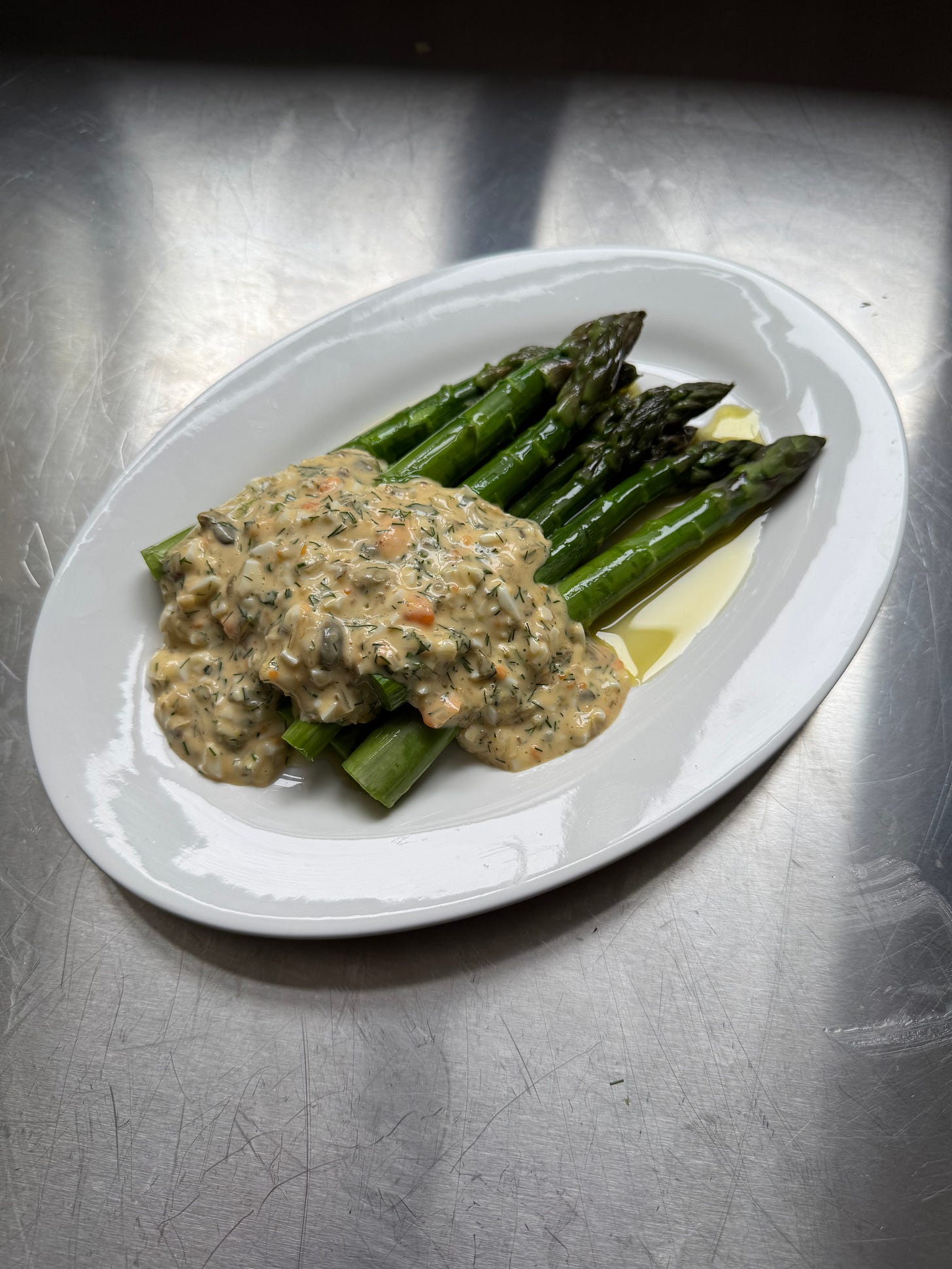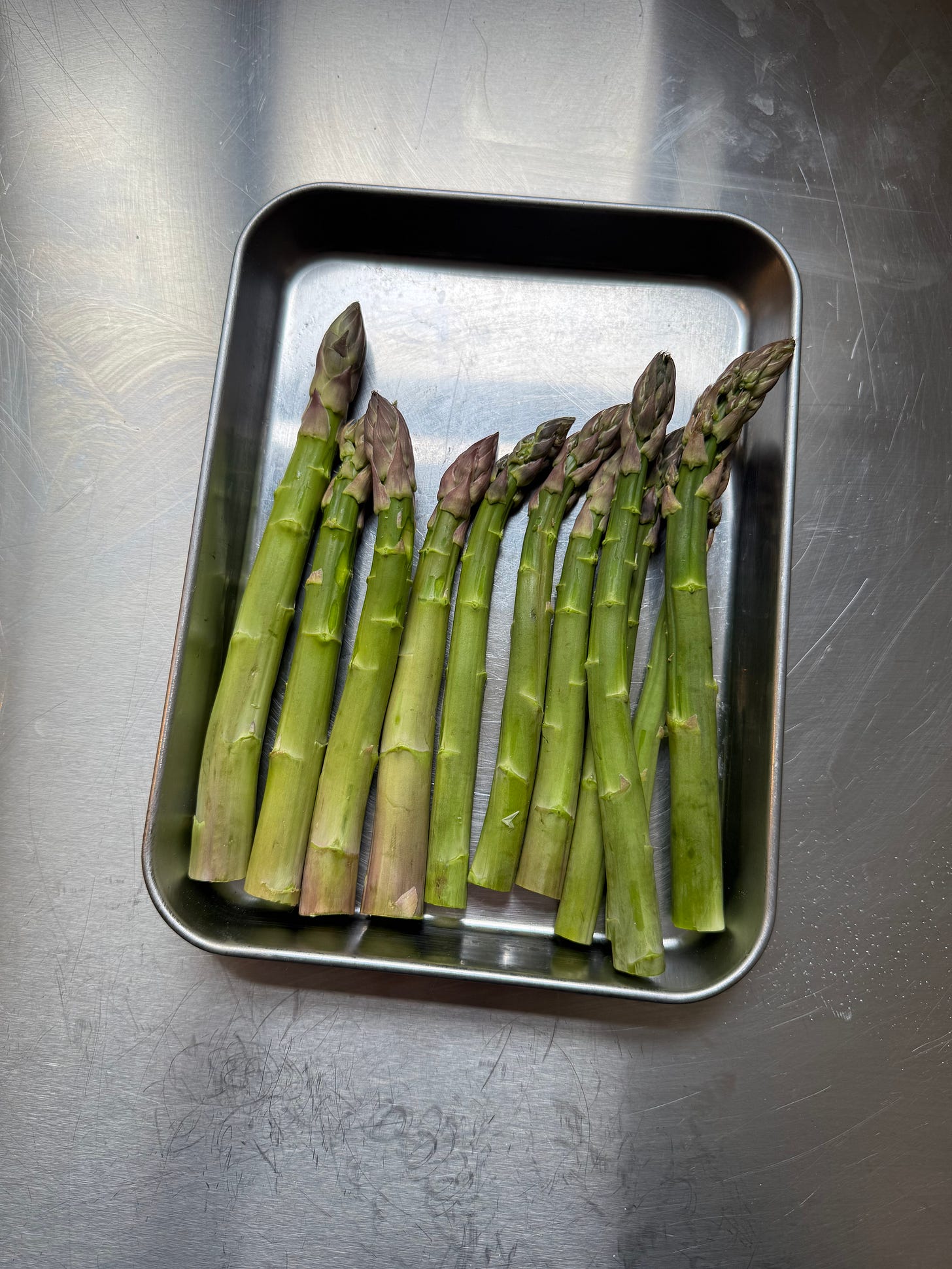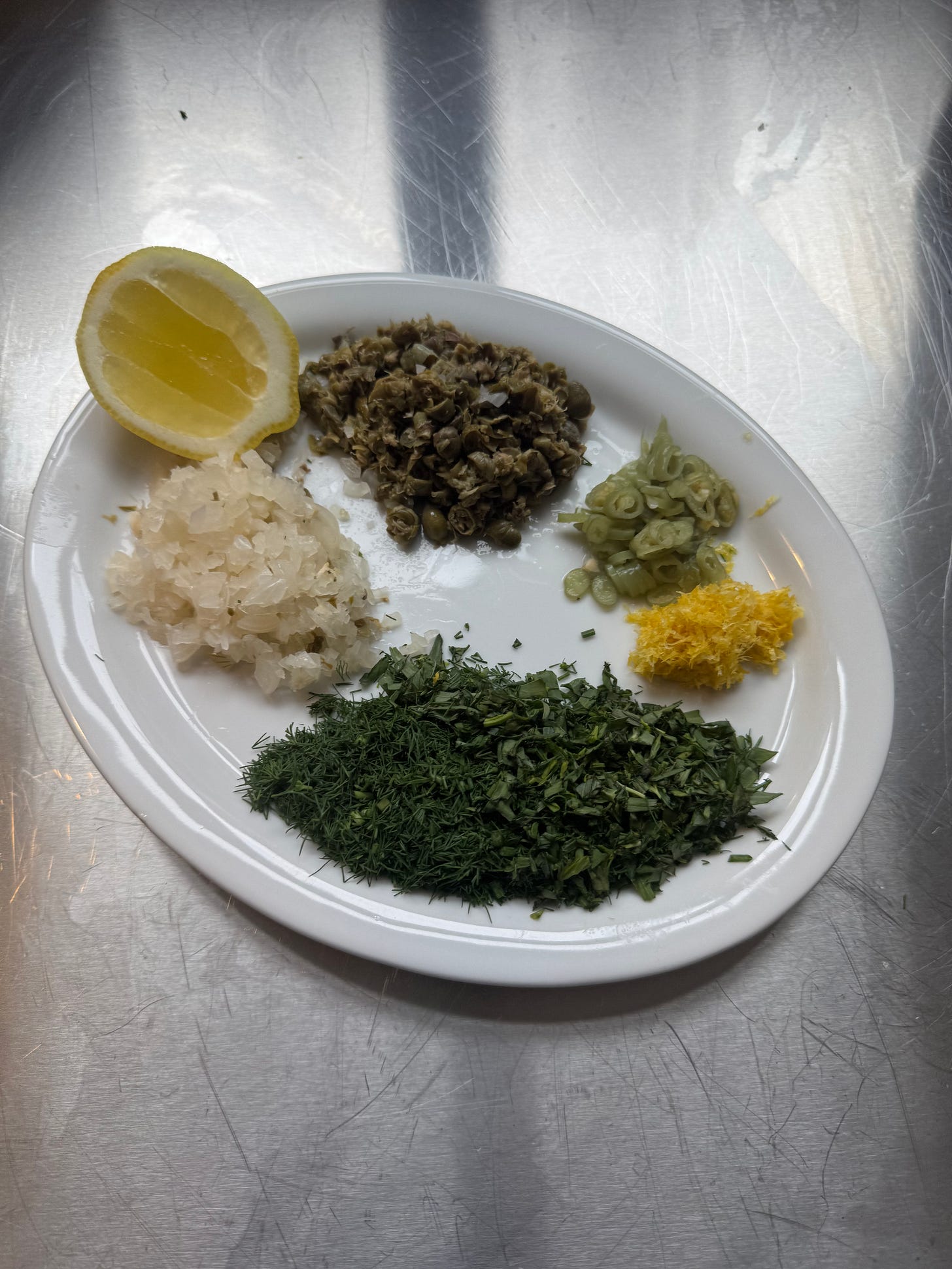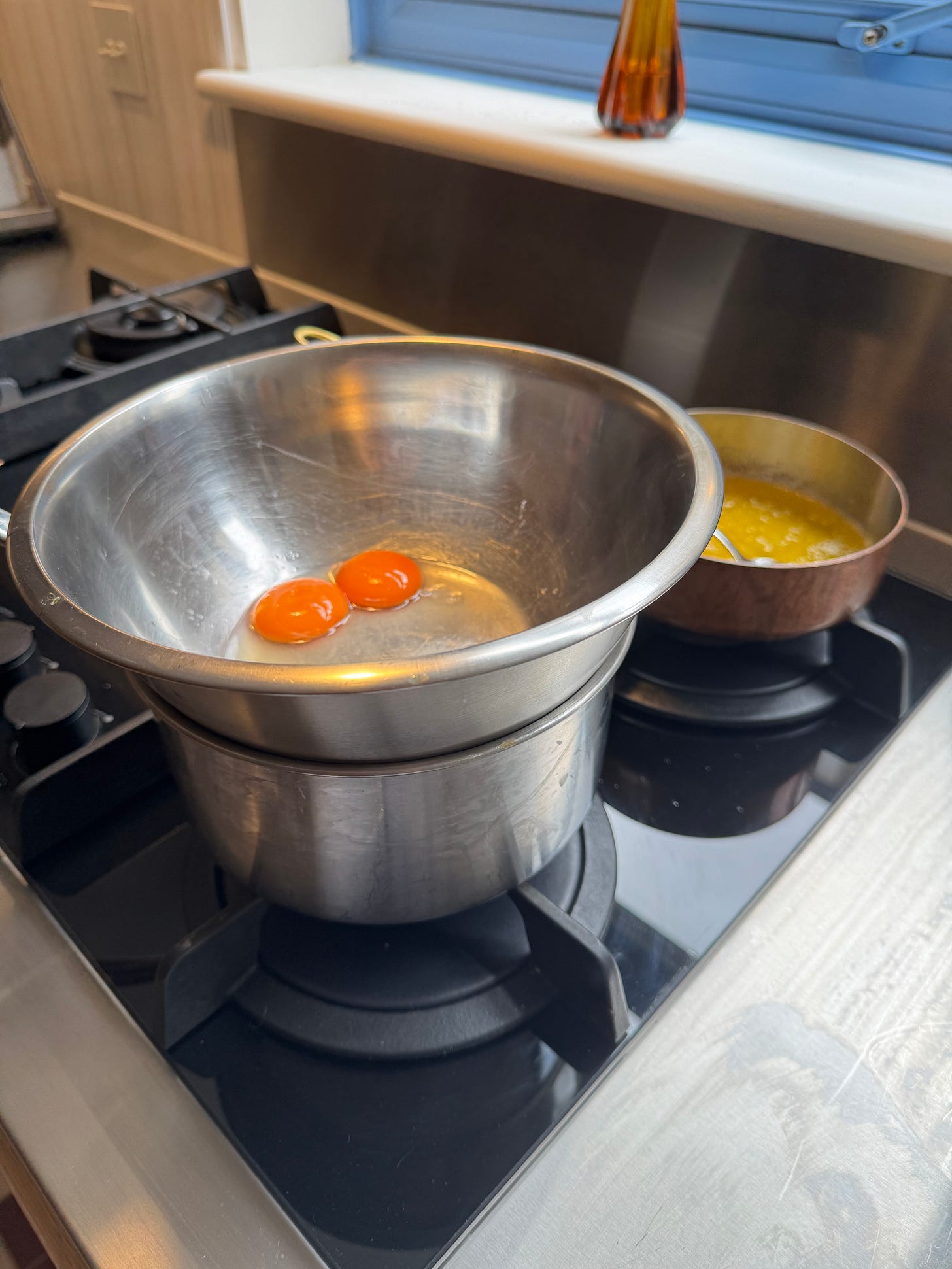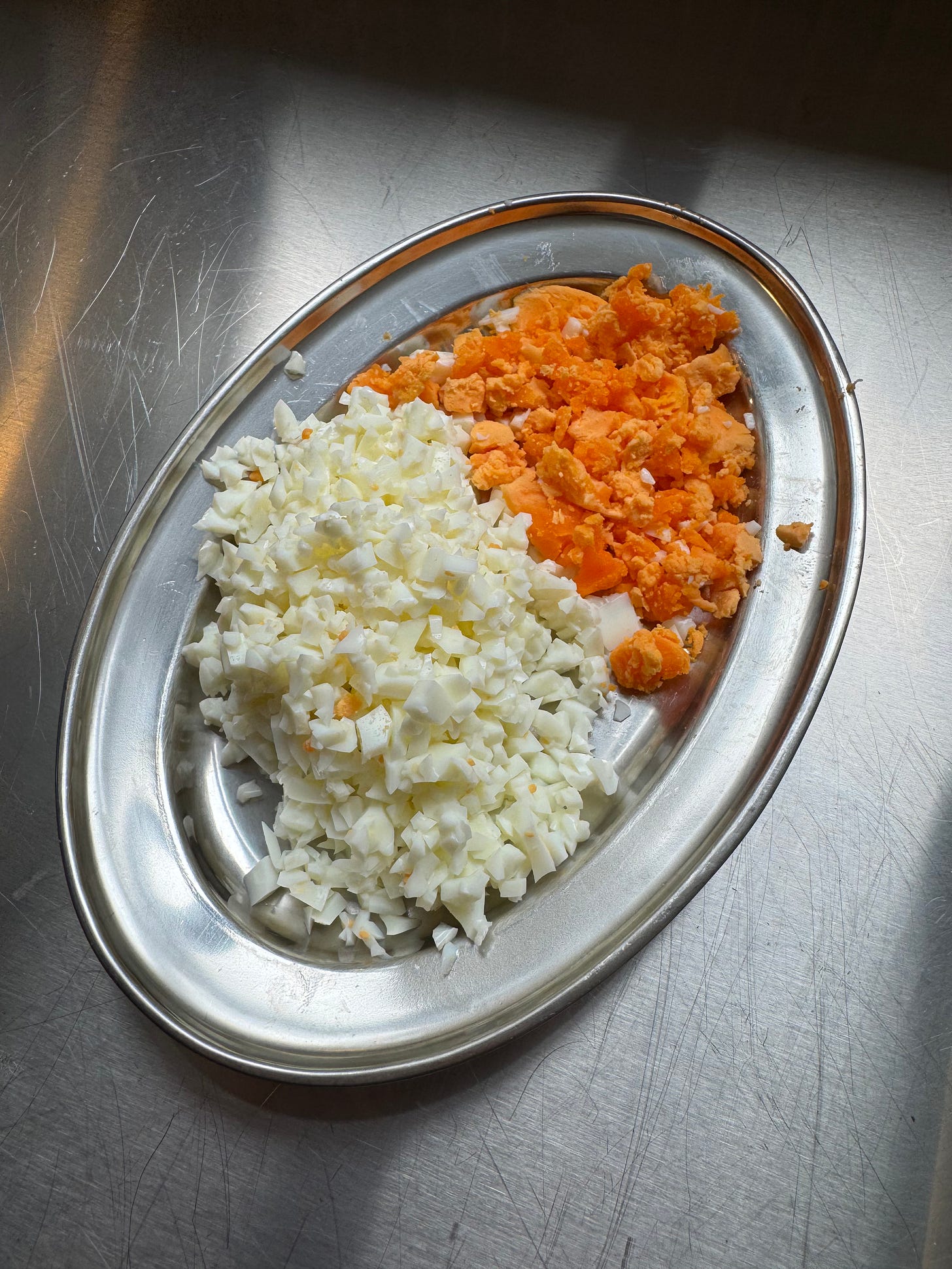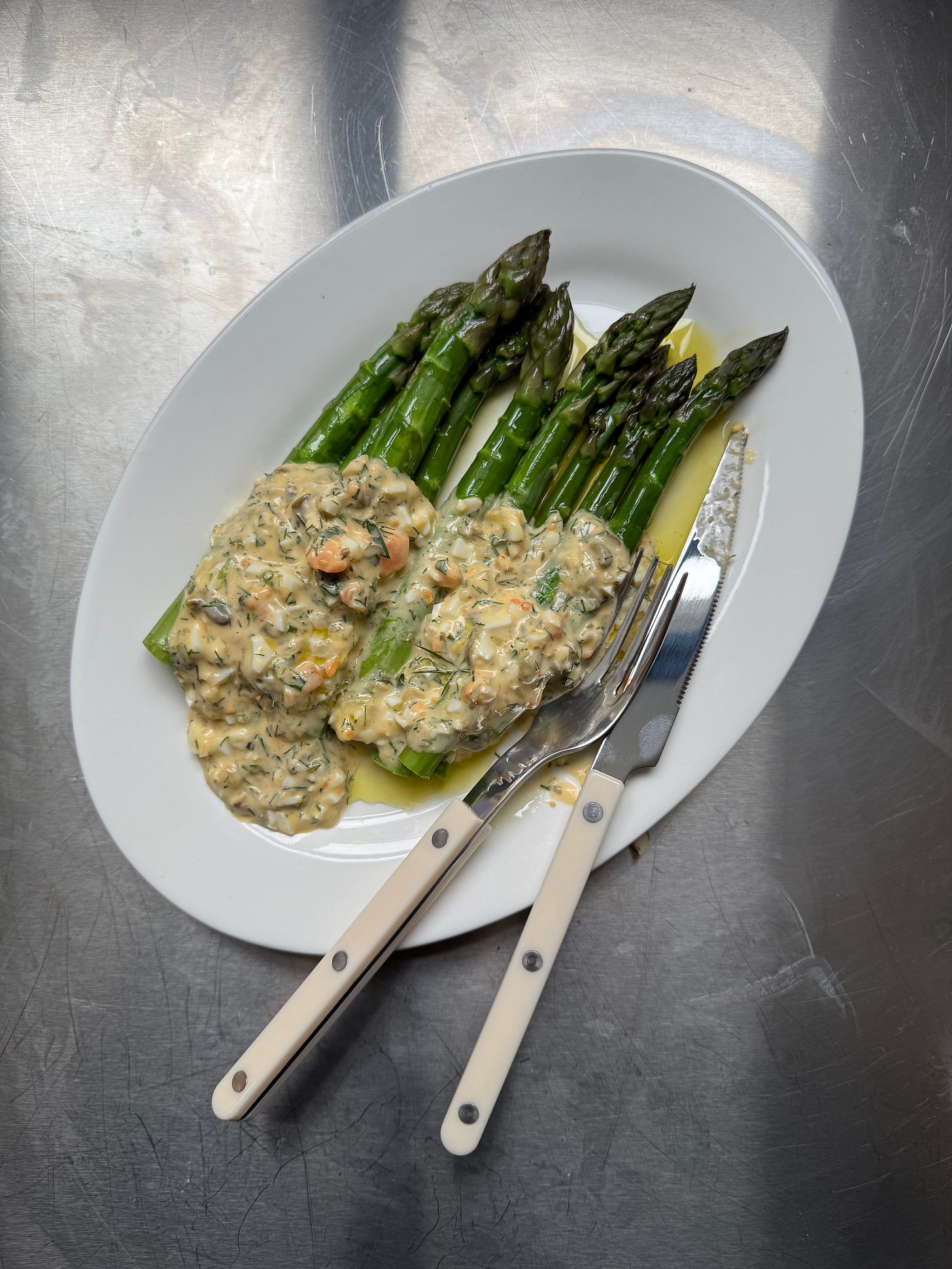Hello hello,
Welcome back to How I Cook+, your weekly dose of technique driven home cooking. This week, we’re cooking vegetables, it’s a special one. Asparagus! We’ve had a packed schedule on How I Cook, and asparagus has been in season for a good few weeks now but we’re not too late, there’s still life in the old spears yet. Get out there, buy a bundle and hit the kitchen
I recently had a chat with the lovely Anna over at Guardian Feast about cooking asparagus, (check that out here). We discussed a take on sauce gribiche, a French emulsified sauce of eggs, cornichons, capers, dill, tarragon and a few other tartar-sauce-leaning characters. It got me thinking about what to write for this week’s issue, and I thought we could take that iconic sauce and throw in a little extra technique. We’re going to make our gribiche with hollandaise today. Asparagus and hollandaise are like peas in a pod, and all we’re doing is pushing it that extra step further into gribiche territory. It’s not only rather chic, but an absolute blast to both make and eat.
I’m in the throws of writing a best man’s speech currently, which is a challenge to say the least, so this week’s offering is a little shorter than normal. I haven’t been able to get much reading done this week, so there’s no book rec for now. There are only so many words one (best) man can read and conjure up!
Happy cooking,
B x
Brown Sugar Tart from How I Cook!
I had my good mate Matt over this week and we did some cooking. As a supremely talented baker himself, I thought it’d be cool if we took a shot at the BST from my brand new cookbook. He taught me a thing or two, a few great little tips and the recipe is still an absolute winner. There’s a video on the way…
I can’t wait to share more recipes from the book with you over the coming months! We’ve just finished the copy edit (aka. sorting out all the words…) so now it’s the final stretch to print! If you haven’t already, please pre-order a copy. Pre-orders are so important for first time authors like me!
To this week’s recipe… I was going to breeze past asparagus season this year and enjoy them in private, but I couldn’t help writing an issue on Spring’s best vegetable. According to the internet, there are a million and one ways to cook asparagus. Sure, there are many ways to skin this cat, but only two really work for me. I like my asparagus very quickly blanched in extremely salty water or grilled over a very hot bbq. Both yield a spear with a fresh, juicy texture and asparagus that is still full of life. If you overcook it, the texture becomes stringy and the flavour astringent. It’s tricky then to incorporate asparagus into anything that needs to be cooked for north of four or five minutes. An asparagus quiche isn’t really for me, nor a tart or a traybake. The results are never, ever as good as a few spears, trimmed and quickly cooked.
ASPARAGUS 101
So, you’ve wandered into the supermarket or green grocer, and a pile of asparagus is staring back at you. Hundred of spears, bunched up into little bundles. Essentially, they look all the same, but there are some signs you can look for that’ll ensure you’re selecting the best of the season. You’re looking for spears that are thick and firm, don’t be afraid to give them a little squeeze. As asparagus ages, they lose moisture and become hollow. If the spears feel bouncy or have a little give in them, put them down and walk away! The bottom of super fresh spear will ooze a bit of juice when given a squeeze. Colour wise, you want to find a bunch that is a deep rich green colour that tapers into white at the base. The tops of the spears should be tightly bunched and super firm, almost rock hard to the touch. If they’re splaying out or easily fall off, walk away.
PREP + COOK
Step one is removing the woody end bit. If you slice instead of snap, this massively reduces the amount of waste. Use your fingers to feel where the rock hard end begins to yield into the green, juicy part of the spear and then use a sharp knife to nip off the root.An optional but nice step is to peel off the little purple barbs that run up the spear. When cooked, they can be quite papery to eat and sometimes trap little bits of dirt as the asparagus grows up and out of the ground. Just use the tip of a knife to peel them away. It’s not completely essential, but a nice touch.
Now when it comes to cooking, you have a few options. The beautiful thing about new season asparagus is just how juicy it is when cooked perfectly. In my book, we want to lean into this, and try and keep everything super crunchy and bursting with that delicious juice. You can 100% eat asparagus raw, thinly sliced in a salad or over burrata with olive oil and lots of lemon juice, but just cooked spears are my favourite. I like to blanch my asparagus very quickly in very salty water, we’re talking 1-2 minutes absolute maximum. You can also cook them in a butter emulsion for a glossy, rich finish or quickly stir fry. Don’t roast them, they go all floppy and naff. Whatever you do, do not overcook your asparagus, and remember to celebrate the juicy texture.
POSH EGG MAYO
To the garnish…
As aforementioned, this is a take on sauce gribiche, which is in essence, posh egg mayo. What sets it apart from the classic preparation is instead of using a cold, mayonnaise like emulsion to bind the ingredients, we’re going to use hollandaise. A rich, buttery, lemony sauce is the perfect foundation for a great plate of asparagus. There’s a few non-negotiables in the gribiche world. You need herbs, I like dill and tarragon for their intense fragrance. You need something pickled or brined, instead of the classic cornichon, I go for capers and sweet pickled onions. Cornichons are a very powerful ingredient and can steal the show. Finally, you need egg, boiled egg.
HOLLANDAISE 101
Hollandaise isn’t just for eggs benedict folks, in fact, it works much harder deployed elsewhere! A steak with bernaise sauce or a piece of baked cod with a blanket of anchovy hollandaise blows english muffins and cold ham out of the water.
So you’ve made mayonnaise before? If you’ve been reading this newsletter for a while, the chances are that you’ve given the classic emuslision a whirl. The key difference when building a hollandaise is that your ingredients are warm. You combine yolks with acid and cook them over a double boiler to “ribbon stage”. Next step, whisk in warm butter to form a rich, thick sauce. It is, in essence, that easy.
It’s important that you understand the texture you’re shooting for with your eggs. Once you’ve combined the yolks with acid, it’s time to start whisking over a pan of hot water. This technique is how you make zabaglione or any sabayon “egg foam”. The goal is to gently cook and thicken the eggs. They will then yield a slightly more stable and much thicker sauce. I find this process takes only between 1-2 minutes with the quantity we’re cooking today. Keep an eye on it, keep whisking until your mixture has roughly doubled in volume and is very thick. If it is lumpy or looks scrambled, try again, you’ve gone a little too far. It’s best to lean towards undercooked rather than overcooked. If things are a little too hot or moving too fast, whip the bowl off for a second! Traditionally, a hollandaise is made using a vinegar reduction, often featuring tarragon. I like to sub in lemon juice for ease.
You can make hollandaise using an immersion blender or jug blender but I find the texture is much harder to control. Invariably, the “cheats” examples in Serious Eats and chefsteps are too runny for me. As someone who often makes pasta in a blender and loves an oven chip, for once I prefer the classic method here. Understanding the cook on the eggs and controlling the amount of butte ryou add, bit by bit, affords you a better understanding of the emulsification process and ultimately, more control. Control is king!
BUTTER
Use unsalted butter, always. You can add salt later.
Clarifying the butter isn’t entirely necessary. The flavour is a little cleaner at the other end, and the pure butter fat is far easier to emulsify into the eggs. Clarifying butter is painfully easy. You simply slowly melt butter, wait for a little raft of white milk solids to form on top, and scoop it off with a spoon. That. Is. It. Browning butter for hollandaise is a lovely way to add a very rich, nutty, rounded character to your sauce. To do this, don’t skim off that white raft, stir it back into the butter and cook until it’s golden brown and smells like hazelnuts. You can now make your sauce using this, but be careful not to whisk into the egg base while it’s scorching hot or you’ll have scrambled eggs. You want the butter to be just above blood temperature, hovering around 40°C.
EGGS
Every gribiche needs boiled egg. I opt for an 8 minute cook on the eggs as I want everything nice and firm, giving the sauce body and bounce. Anything north of 8 minutes and the eggs can become, well, too eggy. I also separate the yolks and whites for a more precise chop. How fine you chop is up to you! I sometimes like a really chunky gribiche, something akin to what you might put in an egg and cress sarnie. I went fancy mode for this recipe and chopped everything pretty fine. You are the master of your gribiche, chop as you like!
THE DREADED “SPLIT”
Home cooks can find making an emulsified sauce like this intimidating and oftentimes it’s down to this. The split. Splitting a mayonnaise or a hollandaise is like stalling a car, everyone does it, it happens! Don’t fret, just be ready to fix it. I always have a little shot glass of warm water by the side of my setup, just in case. If things start to go sideways, add a splash and vigorously whisk it in, your sauce should come right back.
But how do you know when your sauce is about to split? As you emulsify your warm butter into the yolks, the texture of the mixture will change. The more butter you add, the thicker the sauce will become. It’ll transform from loose and fluid to thick and jiggly. It should look smooth, creamy and homogenous. If at any point it begins to look greasy, or even with whisking, there’s a layer of emulsified fat sitting in the bowl, add a little splash of water! Keep an eye on things and go with your gut.
I like to make my hollandaise very thick and then adjust the texture with water or lemon juice once my garnish is in. The chopped herbs, pickled bits and egg will affect the texture, so be ready to adjust.
If you let your hollandaise cool, the butter will set, the fats crystallising and the sauce will split. I pop a tea towel over a pan of simmering water, remove it from the heat and sit the bowl on top. This keeps the sauce warm, the gentle steam just kissing the bottom of the bowl. Be sure to give the sauce a good stir now and then, and you’re laughing.
ASPARAGUS & POSH EGG MAYO
INGREDIENTS







